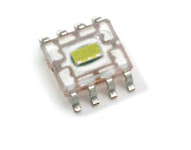4V (50uA) Output Solar Cell in 8-Pin Surface Mount SOIC.
 Clock Loop
Posts: 2,069
Clock Loop
Posts: 2,069

50uA is short circuit current.
http://www.eeweb.com/company-news/ixys/4v-output-solar-cell
$1.40ea
http://www.digikey.com/product-search/en?x=0&y=0&lang=en&site=us&KeyWords=CPC1822


Comments
They also say the device is "a monolithic photovoltaic string of solar cells with switching circuitry". Switching circuitry? Does it do something to prevent reverse leakage when the sun is not out?
I don't know the active area, but suppose each element in the stack is 1 mm^2. Full solar input is about 1mW/mm^2, so if the cell is able to convert all of that to current at 0.5V, the current would be 2mA, but lets generously give it 10% efficiency, so 200µA. Okay, it's in the right ballpark for full sun.
Thanks for the link, I want to try one!
I think where this device REALLY shines (pun?) is how its package is not only smt, small, but also pretty durable, solar cells are usually pretty delicate... and not nearly that small.
By the looks of this, its probably one of the most durable solar cells to date.
So this would be a GREAT way to provide wireless power to any device in the sun, or under a street lamp (or outdoor light thats always on) etc...
Or even remote monitoring stations... an array of these smt cells would juice up a cap, and a battery ....
And do it all in a very very small space.
I personally like this device because of its size, and durable package...
It completely works with smt machines and re-flow processes...
Cell phones need these.
Ran a quick test on it this afternoon. Here is a graph of the results. This was in full sun, measured with LI-COR pyranometer at 973W/m2 and photometer at 102 klux.
Personally I prefer using the Sanyo amorphous solar cells Digikey stocks. They still give good voltage under high efficiency lighting, and can be surface mounted after removing the leads with a temperature controlled iron. Sticking with small crystalline solar cells, a string of BPW34 photo-diodes works well. (up to 0.55V and >1.5mA each in sunlight) Digikey also carries the pre-packaged solar cells that Ixys makes. (again, works great outdoors)
Lawson
Hmm, put two in series? (but you only got 1) Then use diode with desired drop to make v range proper.
Or perhaps a super cap middleman approach...
fwiw Clare (now Ixys?) also make these in 8v versions (at half the current), and an SOIC-16 version with 2x the area. The 8v it easier to charge stuff.
here's the full range